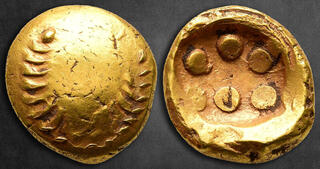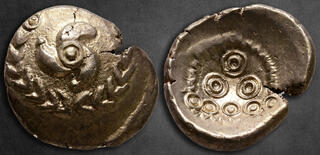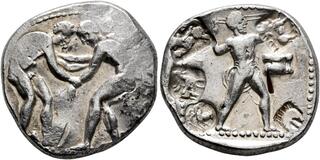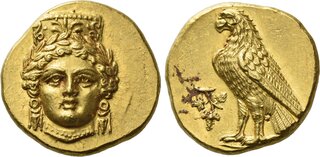Match 1:
Match 2:
Match 3:
Match 4:
| Leu Numismatik AG > Auction 15 | Auction date: 1 June 2024 |
| Lot number: 117 Price realized: This lot is for sale in an upcoming auction - Bid on this lot  | |
| Lot description: ISLANDS OFF CARIA, Rhodos. Lindos. Circa 475-460 BC. Stater (Silver, 25 mm, 13.65 g, 6 h). Head of a roaring lion to right. Rev. ΛΙИ-Δ-[Ι]ΟИ Dolphin swimming right; pellet below; all within incuse square. Cahn, Lindos, Group H. CNG 124 (2023), 226 = Triton XXIII (2020), 438. Gorny & Mosch 280 (2021), 310 var. (slightly differing reverse legend). HGC 6, 1399 = SNG Ashmolean 522 (same dies). HN online 1462. Jameson 2312 = Kunstfreund 12 (same dies). Kraay & Hirmer 781 = Traité I, 781 (same dies). Extremely rare, apparently only the sixth known example. A beautiful example of this important early Rhodian issue. Struck from the ususal worn obverse die and with a minor die break on the reverse, otherwise, very fine. From a European collection, formed before 2005. Before the island of Rhodes united in 408/7 BC to form the polis of Rhodes with a new capital at the northern tip of the island, it was dominated by the triad of Ialysos, Kamiros, and Lindos. The latter was founded in the 10th century BC by Doric immigrants on the site of a former Mycenaean settlement. With its impressive acropolis situated between two natural harbors, Lindos dominated the eastern coast of Rhodes and served as an important cult center not only for the local population but for the entire island community, with its temples dedicated to Athena Lindia and Zeus Polieus situated on the citadel hill. In the 7th century BC, Lindos, along with the cities of Kamiros, Ialysos, Kos, Knidos, and Halicarnassus, joined together to form the Doric Hexapolis, a league of cities likely constituted in response to the establishment of the Ionic League. In the 5th century, when our coin was struck, Lindos was one of the founding members of the Delian League and paid a relatively high annual tribute of 8 talents and 2500 Attic drachms (= 50,500 drachms), which was raised to 10 talents = 60,000 drachms in 450 BC and further increased to 15 talents = 90,000 drachms in 421 BCE. These figures attest to the economic power of the city, which became wealthy through maritime trade thanks to its two excellent harbors. Even after the founding of Rhodes city, Lindos retained its significance as a religious center, and its temple precinct on the acropolis was generously expanded. Today, the ancient ruins overlaid by a mighty Knights Hospitaller castle constitute one of Rhodes' most important tourist attractions, visited annually by hundreds of thousands of tourists. Estimate: 7500 CHF | 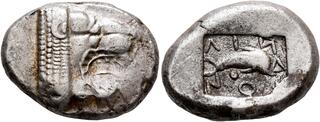 |
Match 5:
| Leu Numismatik AG > Auction 15 | Auction date: 1 June 2024 |
| Lot number: 80 Price realized: This lot is for sale in an upcoming auction - Bid on this lot  | |
| Lot description: KINGS OF PAPHLAGONIA. Amastris, circa 300-285 BC. Stater (Silver, 22 mm, 9.58 g, 1 h). Head of Mên to right, wearing Phrygian cap adorned with a laurel wreath. Rev. ΑΜΑΣΤΡΙΟΣ - ΒΑΣΙΛΙΣΣΗΣ Aphrodite seated left on throne, holding Nike, who crowns her with wreath, in her right hand and lotus-tipped scepter in her left. F. De Callataÿ: Le premier monnayage de la cité d'Amastris, in: SNR 83 (2004), p. 67 and pl. 9, 16a (this coin, D5/R5). HGC 7, 353. SNG Delepierre 2477. SNG von Aulock 6799. Beautifully toned and struck in high relief, a lovely example of this earliest independent coinage of a female ruler in history. Slightly porous and with minor marks, otherwise, good very fine. Ex Giessener Münzhandlung 45, 4 April 1989, 113. As the niece of the last Achaemenid king and wife of two Diadochi and a tyrant, the Persian princess Amastris witnessed the tremendous upheavals of early Hellenism. Born around 340 BC as the daughter of Oxyathres, a brother of Darius III (336-330 BC), she was a direct descendant of Darius II (423-404 BC) and thus came from the highest Persian nobility. Amastris, along with the entire family of Darius III, fell into Macedonian captivity after the Battle of Issus in 333 BC and was married to the distinguished general Krateros by Alexander in the mass wedding at Susa in 324 BC. Like all high-ranking officers of Alexander except Seleukos, Krateros divorced his Persian wife after the king's death, who then married Dionysios, the tyrant of Herakleia Pontika. After her husband's death in 305 BC, she served as queen regent for her eldest son Klearchos under the suzerainty of Antigonos Monophthalmos. In 302 BC, Amastris married the Diadoch Lysimachos, who shortly thereafter defeated Antigonos in alliance with Seleukos I, only to leave his new wife immediately and marry Arsinoe II, the daughter of Ptolemy I. Shortly thereafter, the now twice-abandoned queen founded a new city by synoecism of the towns Sesamos, Kytoros, Kromna, and Tios, which she named after herself - an extraordinary act, as it represents the only known case in antiquity where a queen independently founded and named a city after herself. Undoubtedly, Amastris positioned herself within the early Hellenistic tradition of city foundations, evidently considering herself an equal queen to her male rivals. Although Greek aristocratic women occasionally exerted great political power in the Hellenistic era, Amastris' Persian heritage is likely evident here, as women in Achaemenid society generally held a more independent and influential role than in Greek society. Amastris' position in Herakleia Pontika was so formidable that she eventually became the first woman in history to also mint coins in her own name, of which we have here a particularly well-preserved example. Remarkably, nothing on these coins indicates her role as regent for her son; on the contrary, she appears unambiguously as a βασίλισσα, an independent queen. Therefore, through the figure of the former Persian princess Amastris, we witness not only early Hellenistic history but also an important moment in global cultural history, as the earliest independent coinage by a female ruler holds evident significance. However, the reign of the queen did not end well, for when she died in 285, her sons Klearchos and Oxyathres were suspected of murder by Lysimachus and executed. Nevertheless, her legacy lives on both in her coins and in the founding of her city, which still bears the name Amasra to this day. Estimate: 3500 CHF | 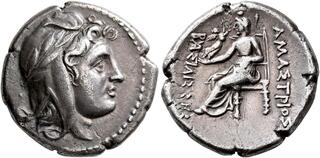 |


